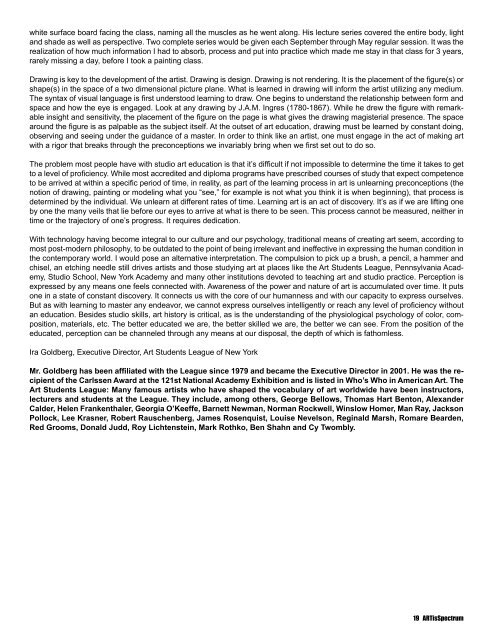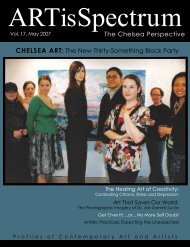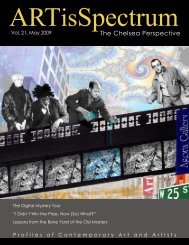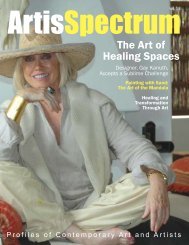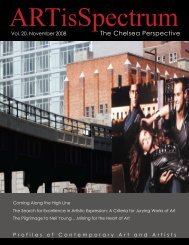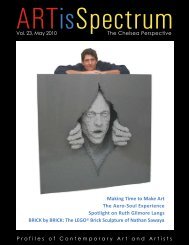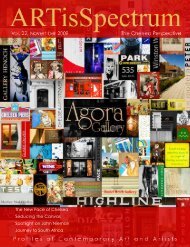Profiles of Contemporary Art and - ARTisSpectrum
Profiles of Contemporary Art and - ARTisSpectrum
Profiles of Contemporary Art and - ARTisSpectrum
Create successful ePaper yourself
Turn your PDF publications into a flip-book with our unique Google optimized e-Paper software.
white surface board facing the class, naming all the muscles as he went along. His lecture series covered the entire body, light<br />
<strong>and</strong> shade as well as perspective. Two complete series would be given each September through May regular session. It was the<br />
realization <strong>of</strong> how much information I had to absorb, process <strong>and</strong> put into practice which made me stay in that class for 3 years,<br />
rarely missing a day, before I took a painting class.<br />
Drawing is key to the development <strong>of</strong> the artist. Drawing is design. Drawing is not rendering. It is the placement <strong>of</strong> the figure(s) or<br />
shape(s) in the space <strong>of</strong> a two dimensional picture plane. What is learned in drawing will inform the artist utilizing any medium.<br />
The syntax <strong>of</strong> visual language is first understood learning to draw. One begins to underst<strong>and</strong> the relationship between form <strong>and</strong><br />
space <strong>and</strong> how the eye is engaged. Look at any drawing by J.A.M. Ingres (1780-1867). While he drew the figure with remarkable<br />
insight <strong>and</strong> sensitivity, the placement <strong>of</strong> the figure on the page is what gives the drawing magisterial presence. The space<br />
around the figure is as palpable as the subject itself. At the outset <strong>of</strong> art education, drawing must be learned by constant doing,<br />
observing <strong>and</strong> seeing under the guidance <strong>of</strong> a master. In order to think like an artist, one must engage in the act <strong>of</strong> making art<br />
with a rigor that breaks through the preconceptions we invariably bring when we first set out to do so.<br />
The problem most people have with studio art education is that it’s difficult if not impossible to determine the time it takes to get<br />
to a level <strong>of</strong> pr<strong>of</strong>iciency. While most accredited <strong>and</strong> diploma programs have prescribed courses <strong>of</strong> study that expect competence<br />
to be arrived at within a specific period <strong>of</strong> time, in reality, as part <strong>of</strong> the learning process in art is unlearning preconceptions (the<br />
notion <strong>of</strong> drawing, painting or modeling what you “see,” for example is not what you think it is when beginning), that process is<br />
determined by the individual. We unlearn at different rates <strong>of</strong> time. Learning art is an act <strong>of</strong> discovery. It’s as if we are lifting one<br />
by one the many veils that lie before our eyes to arrive at what is there to be seen. This process cannot be measured, neither in<br />
time or the trajectory <strong>of</strong> one’s progress. It requires dedication.<br />
With technology having become integral to our culture <strong>and</strong> our psychology, traditional means <strong>of</strong> creating art seem, according to<br />
most post-modern philosophy, to be outdated to the point <strong>of</strong> being irrelevant <strong>and</strong> ineffective in expressing the human condition in<br />
the contemporary world. I would pose an alternative interpretation. The compulsion to pick up a brush, a pencil, a hammer <strong>and</strong><br />
chisel, an etching needle still drives artists <strong>and</strong> those studying art at places like the <strong>Art</strong> Students League, Pennsylvania Academy,<br />
Studio School, New York Academy <strong>and</strong> many other institutions devoted to teaching art <strong>and</strong> studio practice. Perception is<br />
expressed by any means one feels connected with. Awareness <strong>of</strong> the power <strong>and</strong> nature <strong>of</strong> art is accumulated over time. It puts<br />
one in a state <strong>of</strong> constant discovery. It connects us with the core <strong>of</strong> our humanness <strong>and</strong> with our capacity to express ourselves.<br />
But as with learning to master any endeavor, we cannot express ourselves intelligently or reach any level <strong>of</strong> pr<strong>of</strong>iciency without<br />
an education. Besides studio skills, art history is critical, as is the underst<strong>and</strong>ing <strong>of</strong> the physiological psychology <strong>of</strong> color, composition,<br />
materials, etc. The better educated we are, the better skilled we are, the better we can see. From the position <strong>of</strong> the<br />
educated, perception can be channeled through any means at our disposal, the depth <strong>of</strong> which is fathomless.<br />
Ira Goldberg, Executive Director, <strong>Art</strong> Students League <strong>of</strong> New York<br />
Mr. Goldberg has been affiliated with the League since 1979 <strong>and</strong> became the Executive Director in 2001. He was the recipient<br />
<strong>of</strong> the Carlssen Award at the 121st National Academy Exhibition <strong>and</strong> is listed in Who’s Who in American <strong>Art</strong>. The<br />
<strong>Art</strong> Students League: Many famous artists who have shaped the vocabulary <strong>of</strong> art worldwide have been instructors,<br />
lecturers <strong>and</strong> students at the League. They include, among others, George Bellows, Thomas Hart Benton, Alex<strong>and</strong>er<br />
Calder, Helen Frankenthaler, Georgia O’Keeffe, Barnett Newman, Norman Rockwell, Winslow Homer, Man Ray, Jackson<br />
Pollock, Lee Krasner, Robert Rauschenberg, James Rosenquist, Louise Nevelson, Reginald Marsh, Romare Bearden,<br />
Red Grooms, Donald Judd, Roy Lichtenstein, Mark Rothko, Ben Shahn <strong>and</strong> Cy Twombly.<br />
19 <strong>ARTisSpectrum</strong>


